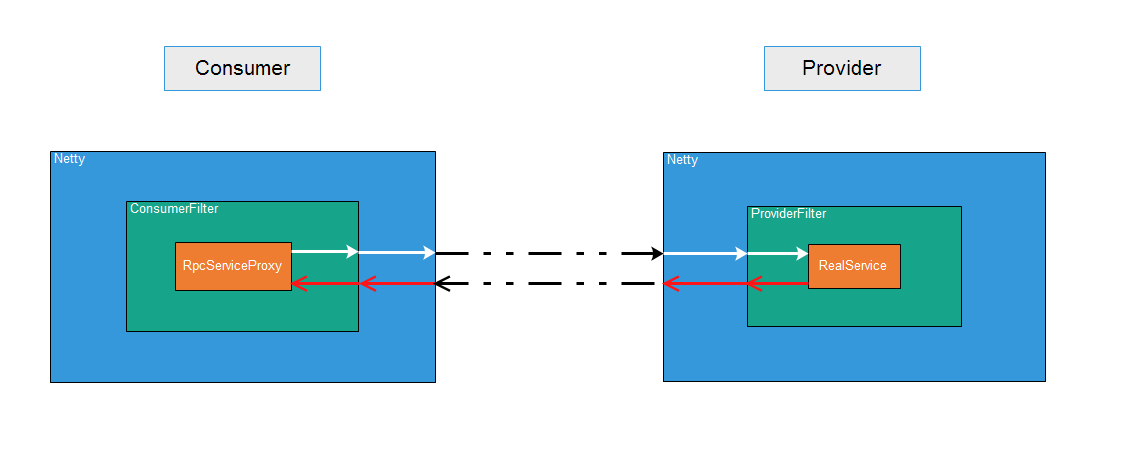Consumer 调用 Provider的过程:

(CONSUMER)
Dubbo服务调用处 --> 调用RPC代理 --> InvokerInvocationHandler#invoke() --> FailoverClusterInvoker#doInvoke() --> ConsumerContextFilter#invoke(Invoker, Invocation) --> DubboCodec#encodeRequestData(Channel channel, ObjectOutput out, Object data)
=========》》》(PROVIDER)
DubboCodec#decodeBody(Channel channel, InputStream is, byte[] header) --> ContextFilter#invoke(Invoker, Invocation) --> ExceptionFilter#invoke(Invoker, Invocation) --> 通过 JavassistProxyFactory#getInvoker() 产生的代理对象来调用真正的Service --> ....反向穿过之前的Filter --> DubboCodec#encodeResponseData(Channel channel, ObjectOutput out, Object data)
========》》》(CONSUMER)
DubboCodec#decodeBody(Channel channel, InputStream is, byte[] header) --> ConsumerContextFilter#invoke(Invoker, Invocation) --> FailoverClusterInvoker#doInvoke() --> InvokerInvocationHandler#invoke() --> 回到调用处
附:
Dubbo Provider端(服务端)的异常会放在 RpcResult 中,然后再经过 Provider 端的 ExceptionFilter 处理。
AbstractProxyInvoker#invoke(Invocation):

public Result invoke(Invocation invocation) throws RpcException { try { return new RpcResult(doInvoke(proxy, invocation.getMethodName(), invocation.getParameterTypes(), invocation.getArguments())); } catch (InvocationTargetException e) { return new RpcResult(e.getTargetException()); // 异常放在 RpcResult 对象中 } catch (Throwable e) { throw new RpcException("Failed to invoke remote proxy method " + invocation.getMethodName() + " to " + getUrl() + ", cause: " + e.getMessage(), e); } }
Consumer端收到 Provider 端序列化过来的 RpcResult,会调用 RpcResult#recreate(),来还原结果。如果 RpcResult 中有异常,则会 throw 异常

InvokerInvocationHandler#invoke() public Object invoke(Object proxy, Method method, Object[] args) throws Throwable { String methodName = method.getName(); Class<?>[] parameterTypes = method.getParameterTypes(); if (method.getDeclaringClass() == Object.class) { return method.invoke(invoker, args); } if ("toString".equals(methodName) && parameterTypes.length == 0) { return invoker.toString(); } if ("hashCode".equals(methodName) && parameterTypes.length == 0) { return invoker.hashCode(); } if ("equals".equals(methodName) && parameterTypes.length == 1) { return invoker.equals(args[0]); } return invoker.invoke(new RpcInvocation(method, args)).recreate(); // 得到 Provider 端的结果 RpcResult,然后调用 recreate() 还原结果 } RpcResult#recreate() public Object recreate() throws Throwable { if (exception != null) { throw exception; } return result; }
FailoverClusterInvoker#doInvoke() : dubbo的异常重试逻辑,默认重试2次,表示加上第一次调用,会调用3次
com.alibaba.dubbo.remoting.exchange.support.DefaultFuture : Dubbo 获取 Rpc 调用结果的处理
com.alibaba.dubbo.rpc.protocol.dubbo.DubboCodec : Dubbo Request与Response消息的编码、解码处理
Consumer 调用 Provider 写出的数据包:(DubboCodec.java)
protected void encodeRequestData(Channel channel, ObjectOutput out, Object data) throws IOException { RpcInvocation inv = (RpcInvocation) data; out.writeUTF(inv.getAttachment(Constants.DUBBO_VERSION_KEY, DUBBO_VERSION)); out.writeUTF(inv.getAttachment(Constants.PATH_KEY)); out.writeUTF(inv.getAttachment(Constants.VERSION_KEY)); out.writeUTF(inv.getMethodName()); out.writeUTF(ReflectUtils.getDesc(inv.getParameterTypes())); Object[] args = inv.getArguments(); if (args != null) for (int i = 0; i < args.length; i++){ out.writeObject(encodeInvocationArgument(channel, inv, i)); } out.writeObject(inv.getAttachments()); }
Provider 被调用后回给 Consumer 的数据包:(DubboCodec.java)
protected void encodeResponseData(Channel channel, ObjectOutput out, Object data) throws IOException { Result result = (Result) data; Throwable th = result.getException(); if (th == null) { Object ret = result.getValue(); if (ret == null) { out.writeByte(RESPONSE_NULL_VALUE); } else { out.writeByte(RESPONSE_VALUE); out.writeObject(ret); } } else { out.writeByte(RESPONSE_WITH_EXCEPTION); out.writeObject(th); } }
由此可以看出:
1. Consumer 会向 Provider 传递 attachment
2. Provider 回给Consumer的只有调用的结果数据或者异常信息
3. Consumer 端配置优于 Provider 端的配置(因为 Coumer 向 Provider 传递了配置的参数,这是Dubbo 的配置覆盖原则)
附:
dubbo 使用细节 : http://www.cnblogs.com/php0368/p/4290791.html
如果想了解更多Dubbo源码的知识,请移步 Dubbo源码解读——通向高手之路 的视频讲解:
http://edu.51cto.com/sd/2e565
